| Life
in the Mississippi1
by
Howard Webb (St. Louis, MO, USA) |
Introduction
For some time I have been wanting to
investigate daphnia beyond the reaches of dipping a pole
over the bank of a pond; in particular I have been curious about the
spread of Daphnia lumholtzi, a non-native cladocera. An opportunity
opened up in mid-October, and I went canoeing on the Mississippi
River to see what I could find. Some studies indicated that the
population of D. lumholtzi drops below detectable levels by November,
so I had uncertain expectations for this late in the season.
About Daphnia lumholtzi
Daphnia lumholtzi is an exotic "water
flea", originally from Africa or Australia; and possibly brought
into the United States via the tropical fish trade. There has been
concern that its distinctive spines may give it a defensive advantage
(against predators) over native cladocera, possibly changing some of
the dynamics of local food chains.
In 1995, Daphnia lumholtzi were first found
in the Illinois River. Since the confluence of the Illinois River and
the Mississippi is only a few miles above where I was sampling; D.
lumholtzi were likely to have floated into the basin, if not having
set up a permanent population.
Compared to earlier experiments with the
plankton net (on Simpson Lake), the results were quite good. For the
short time I was actually towing the net, I collected over 100
cladocera. The surprise was the distribution of species; there were
about a half dozen Daphnia mendota2, and the same number
of Moina, the rest were all D. lumholtzi. The diverse sizes of the D.
lumholtzi indicated a dynamic population, not just a few late season
adults.
Technique
I used my plankton
net; making both vertical tows (letting it drop to the bottom,
then pulling it straight up), and pulling it along behind the canoe
while paddling around. There was not enough current to anchor in one
place and catch the flow of the river.
Images
The first images are of live specimens, taken the same
day as collected. To avoid injuring the daphnia, no cover slip was used. This
is a trade off between a natural looking specimen, and better optics and images.
The displayed images have been reduced and sharpened, click on any image to
see the full size (file size is of the full sized image).
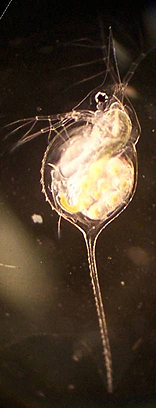
|
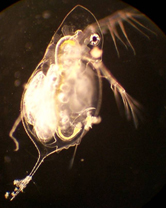
|
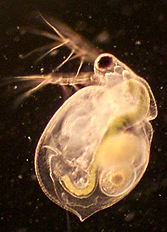
|
| Daphnia
lumholtzi
40x, dark field, best mode
less than 50K file
|
Daphnia
mendota
40x, dark field, best mode
less than 50K file
|
Moina
sp?
100x, dark field, best mode
less than 50K file
|
The following are a daphnia that was kept for several days before photographing,
using a cover-slip. The latter two images are esencially the same, except for
focus.
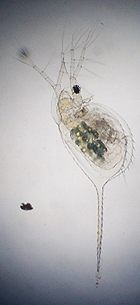
|
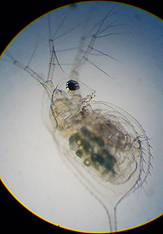
|
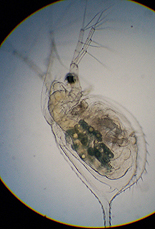
|
Daphnia
lumholtzi
10x bright field, best mode
110K file
|
Daphnia
lumholtzi
100x bright field, best mode
406K file
|
Daphnia
lumholtzi
100x bright field, best mode
397K file
|
The limitations of my old Kodak are beginning to show. On the bright field
images, the automatic light adjustment makes it appear as if the condenser iris
is closed down too far. Visually this is not so, but the shadow is an artifact
of the camera trying to create a uniform grey level (and not having controls
to override the settings).
A Note on Safety
Boating on the Mississippi can be quite
dangerous, especially in a small craft. Commercial barge-tows ply the
main channel, and significant currents exist in many places.
I deliberately chose a location known as the
"Alton basin", what is essentially a lake behind one of the
river's major lock and dams (Alton lock and dam, #26).
At this point the lock is 20km downstream, and the river is 1.4km
wide. There is virtually no current in this part of the river, and by
staying among the islands, and out of the main channel; all
commercial, and most recreational traffic can be avoided. The canoe
has an outrigger which greatly increases the stability, and we wear
life-vests at all times. I also picked a day with no wind and good
visibility.
Technical Details
Environmental
Conditions:
Water
temperature: 18 C.
Depth: 5 meters
Secci
visibility: 0.5 meters
Location: UTM 15
728459E 4313696N (mile 214 on the river)
Microscope:
Bauch & Lomb monocular, 10x ocular, 4x, 10x and 40x
objectives.
Camera: Kodak 3200 Digital, best mode
1152x864
Software: Photoshop Elements
References
1Apologies to Mark Twain and his
book Life
on the Mississippi
2 There
is some debate if this is Daphnia mendota, or a hybrid: Daphnia
mendota galeata
Other articles on D. lumholtzi
USGS
Illinois
Natural History Survey
INHS
Doc #2068
© Microscopy UK or
their contributors.
Published in the
January 2004 edition of Micscape Magazine.
Please report any
Web problems or offer general comments to the Micscape
Editor,
via
the contact on current Micscape Index.
Micscape is the
on-line monthly magazine of the Microscopy UK web
site
at http://www.microscopy-uk.org.uk/





